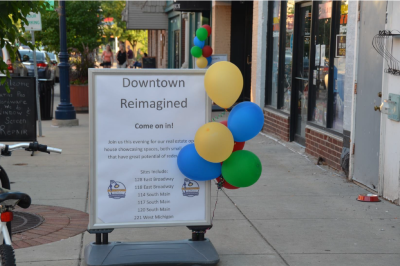At recent years’ events, the League and our affiliates have had a number of appearances by Chuck Marohn from Strong Towns, as well as related speaker Joe Minicozzi from Urban3. Marohn and Minicozzi both work to connect the dots between land use patterns, infrastructure decisions, and municipal revenues, showing how conventional, auto-oriented suburban development can lock us into permanent deficits.
But–how are communities actually applying these lessons at the local level? This year, we asked three communities to share their experiences engaging with the Strong Towns message, and to offer up some “as applied” thoughts.
Mayor Nancy DeBoer of Holland talked about her city’s making it to the final four round in the first ever “Strongest Town” competition in 2016, based on the feeling that the principles laid out in the Strong Towns Strength Test fit Holland well.
She specifically mentioned an incremental approach to improving downtown street function, through paint and signs alone in some cases, and an insistence in engaging developers through a framework of long-term fit and contributions to the community, rather than looking only at the immediate payoff.
Mayor Kathy Ling of Mount Pleasant discussed bringing Marohn to her city as part of a fresh look at their economic development approaches and the long overdue update of their 40-year-old zoning ordinance.
 In particular, asking, “If your favorite street in town didn’t exist, would your local codes allow it to be built today?” has been a useful exercise in the zoning discussion. Working with entrepreneurs through regular popup events has also helped new downtown businesses test the waters.
In particular, asking, “If your favorite street in town didn’t exist, would your local codes allow it to be built today?” has been a useful exercise in the zoning discussion. Working with entrepreneurs through regular popup events has also helped new downtown businesses test the waters.
She noted that some ideas hadn’t clicked locally yet: expanding the ability to add ADUs, duplexes, or other “missing middle” housing types is a fraught conversation in a community with 20,000 college students. When existing rental properties offer many examples of nuisance and poor upkeep, requiring care in expanding such options.
Commission Gary Howe of Traverse City has a personal relationship to Strong Towns dating from before elected service, when he was “the bike lane blogger” in town, and Strong Towns helped him better articulate the connections from a walking- and biking-friendly town to an economically healthy community.
This past year, Traverse City both won the 2017 Strongest Town contest and brought in Joe Minicozzi to create value-per-acre maps for both the city and the county. He said this helped the city better talk about where and how to use incentives in coordination with benefit, and especially urged the audience to think of auto-oriented suburban public infrastructure as its own subsidy when looking at use of other subsidies downtown, in order to provide a balanced discussion.

In all three cities, one issue we often speak of as a hindrance can instead seem a benefit through the lens of fiscal productivity: the cities are generally “landlocked” by their surrounding townships, and have seen minimal geographic growth in recent years. This means that the more enduring value of their traditional downtowns and neighborhoods is located within the city limits, while the more ephemeral value of big box stores and the like has happened beyond their borders. While the cities may be “missing out” on the revenue boost of these newer developments, they are later insulated from the liability of maintaining those areas as they age.
We always love to see our members applying the ideas they’ve heard at Convention, whether it’s the message of Strong Towns or any of our other content, and reporting back on how it went. Please let us know what you take home from our events, and how we can help you put ideas to practice!
